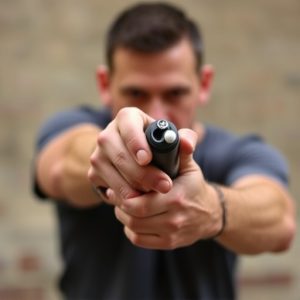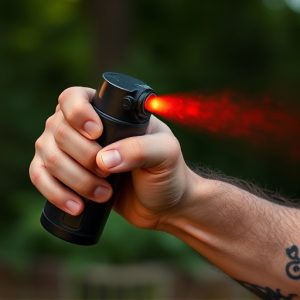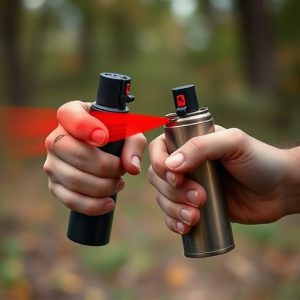Spray and Move: Mastering Pepper Spray Defense Techniques
Pepper spray, a powerful personal defense tool that uses capsaicin to temporarily disable attackers…….
Pepper spray, a powerful personal defense tool that uses capsaicin to temporarily disable attackers by causing intense eye and respiratory irritation, is most effectively used with the "Spray and Move" technique. This involves spraying the irritant while retreating to create distance from the assailant, leveraging the body's natural 'fight or flight' response. Mastering this deployment technique, understanding legal boundaries, and following safety protocols are key for optimal use of pepper spray as a self-defense measure.
“Uncover the power of pepper spray as a personal defense mechanism in this comprehensive guide. We explore its composition, the science behind its effectiveness, and why the ‘spray and move’ deployment strategy is key to self-protection. From understanding the active ingredients to mastering defensive techniques like Spray and Move Deployment Techniques, this article equips you with vital knowledge for navigating potential threats. Learn about legal considerations and safety precautions, empowering yourself with a practical tool in today’s world.”
- Understanding Pepper Spray: Its Composition and Effects
- The Psychology Behind Fear and Flight Response in Potential Threats
- Effective Spray and Move Deployment Strategies
- Legal Considerations and Safety Precautions for Self-Defense with Pepper Spray
Understanding Pepper Spray: Its Composition and Effects
Pepper spray, a potent deterrent, is a chemical agent designed to temporarily incapacitate an attacker by causing severe irritation and pain in the eyes and respiratory system. Its composition includes capsaicin, the active ingredient found in chili peppers, which when sprayed into the face or eyes, leads to a strong inflammatory response. The effects are swift but temporary, allowing individuals to create distance from their assailant and seek safety.
Effective deployment techniques play a crucial role in maximizing pepper spray’s deterrence. The recommended strategy is to “spray and move,” where the user releases the spray towards the attacker while quickly retreating. This ensures optimal coverage and minimizes exposure to the irritant, providing a critical window of opportunity for escape. Understanding the spray’s range, wind dynamics, and the target area’s visibility are essential skills for anyone considering pepper spray as a self-defense mechanism.
The Psychology Behind Fear and Flight Response in Potential Threats
The human response to potential threats is deeply rooted in our evolutionary past, where staying alive often hinged on a quick decision to either fight or flee. This innate reaction involves complex neural pathways that trigger the release of stress hormones like adrenaline, preparing the body for action. When faced with a perceived danger, individuals might experience fear, which can manifest as a strong urge to escape, known as the flight response.
In the context of self-defense tools like pepper spray, understanding this psychological phenomenon is crucial. Spray and Move deployment techniques leverage the individual’s natural instinct to move away from an irritant. By spraying the potential attacker while retreating, users can create distance, disrupt the assault, and buy themselves time to escape further, all relying on the body’s instinctive fear-driven response to flee the source of danger.
Effective Spray and Move Deployment Strategies
When utilizing pepper spray as a self-defense mechanism, employing effective Spray and Move deployment strategies is paramount. The key lies in combining swift application with strategic retreat. Users should aim for vulnerable areas like the face, eyes, and nose, firing from an arm’s length distance. Once sprayed, immediately take several steps back to create distance between yourself and the assailant, allowing the spray to take effect while maintaining your own safety.
These Spray and Move Deployment Techniques are crucial for maximizing the effectiveness of pepper spray. By combining direct but controlled application with a strategic retreat, individuals can deter attacks, disrupt the aggressor’s balance, and create an opportunity to escape.
Legal Considerations and Safety Precautions for Self-Defense with Pepper Spray
When employing pepper spray as a self-defense mechanism, understanding legal boundaries and safety protocols is paramount. The use of pepper spray for self-defense falls under various legal considerations that differ by region. In many jurisdictions, individuals have the right to protect themselves, but excessive force or its misuse can lead to legal repercussions. It’s crucial to familiarize yourself with local laws regarding the possession and application of pepper spray, including age restrictions, permissible scenarios, and any required permits.
Safety precautions should always be a top priority when handling and deploying pepper spray. Proper training in Spray and Move deployment techniques is essential to ensure effectiveness and minimize harm. This involves learning how to accurately assess threats, choose the right spray can for the situation, and employ swift, strategic movements to retreat after spraying. Additionally, maintaining awareness of your surroundings post-deployment is vital to prevent potential counterattacks.
Pepper spray, as a powerful self-defense tool, leverages an individual’s natural flight response by inducing temporary blindness, coughing, and difficulty breathing. Understanding its composition, psychological effects, and effective deployment strategies, like the Spray and Move technique, is crucial for responsible use in real-world scenarios. Always prioritize safety and familiarize yourself with local laws to ensure a legal and effective defense mechanism.


